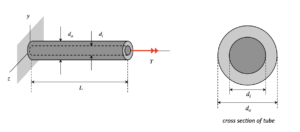Problem statement
Solution video
DISCUSSION THREAD

Please post questions here on the homework, and take time to answer questions posted by others. You can learn both ways.
Problem statement
Solution video
DISCUSSION THREAD

You must be logged in to post a comment.
C and A are the same questions, right?
Yes, I’d assume it’s a typo
Actually I read it wrong, A is shear stress and C is shear strain.
Oh, ok, thank you!
They revolve around the same part of the shaft but A asks for shear stress and C asks for sheer strain. Hope this helps!
Do we just use the right hand rule to determine the torque? I don't understand how it can be applying torque when it is pulling straight out of the shaft.
Since the direction of the torque does not matter for shear calculation (as in it's not really important if the torsion is clockwise or counterclockwise) just use the value given for torque and plug it into the formula t(p)/j.
It is similar to the last homework assignment in that the torque formula is what really matters and other than that the right hand rule still applies to the forces but the force, T, is in line with the distance from the wall so the torque when measured at 180 degrees is always zero.
I don't think the direction of the torque matters for the shear value. It would be the same regardless of the direction of the torque.
I believe the torque vector is shown as the direction your thumb would point when using the right-hand rule (so there's a counterclockwise twist on the shaft looking at it from the non-fixed side, not a force pulling on the shaft).
The torque pointing straight out is the direction of your thumb while doing the right hand rule, we define torque/moment and other cross products by the direction perpendicular to the plane which is formed by the torque/moment. In this example, the positive X torque would cause a tendency to rotate counterclockwise in the yz-plane.
Would we ever see a question like this that would ask us to determine a minimum tube thickness (the same way we have seen to determine shaft size)?
The thing about tube thickness is that it isn't really related to stress or strain. For example, a tube with a 1 inch wall thickness and a 3 inch inner diameter would have a far different stress given a certain applied torque than a tube with a 1 inch wall and a 5 inch inner diameter. The part that is related to stress and strain is the actual values of the inner and outer diameter. I could imagine they might give us one of these two diameters and have us solve for those. However, solving for the outer diameter may be unreasonably difficult so I think that it would make more sense if they gave us an outer diameter and asked us to solve for the inner diameter.
Once again, no evidence that they'd put that on an exam but I don't imagine it would be too difficult.
How do we use G in solving the problem?
You need to use it and stress to solve for the strain in the equation:
shear stress=(shear modulus)*(shear strain)
For part a, is converting the Torque from 30 kip/ft to 360kip/inch correct?
Yes, that's what I did in order to get a unit of ksi at the end. You will also need part A in ksi so you can determine the max shear strain with G which is also in ksi.
Regardless of strain and stress, outer surface of them would be at max right?
Yes, it would be at the outer surface (larger radius in the numerator for the stress formula).
I would tell my classmates to make sure they convert the 30kip/ft to 360 kip in. Also keep part a in ksi to cancel the G in the later equation
The conversion of unit is tricky in this problem. Make sure you read the question carefully. The problem says kip-ft for torque, but all radiuses are using inch as unit.